
Victories won by activists around the world tops our list of the big environmental stories of the year. In this photo: a young woman is placed in handcuffs and arrested for civil disobedience against the Keystone XL Pipeline in the U.S. In all, 1,252 people were arrested in the two week long action. Photo by: Josh Lopez/Tar Sands Action.
People flex their strength, climate change accelerates, and Indonesia works to stem deforestation. Below is a review of some of the biggest environmental stories of 2011.
People power: activism makes good (Hance)
Many of 2011’s most dramatic stories on environmental issues came from people taking to the streets. With governments and corporations slow to tackle massive environmental problems, people have begun to assert themselves. Victories were seen on four continents: in Bolivia a draconian response to protestors embarrassed the government, causing them to drop plans to build a road through Tipnis, an indigenous Amazonian reserve; in Myanmar, a nation not known for bowing to public demands, large protests pushed the government to cancel a massive Chinese hydroelectric project; in Borneo a three-year struggle to stop the construction of a coal plant on the coast of the Coral Triangle ended in victory for activists; in Britain plans to privatize forests created such a public outcry that the government not only pulled back but also apologized; and in the U.S. civil disobedience and massive marches pressured the Obama Administration to delay a decision on the controversial Keystone XL pipeline, which would bring tar sands from Canada to a global market. However, expect some of these battles to rear their heads again: already the U.S. Congress is moving to force the Obama Administration to make a determination on the pipeline quickly. Despite overwhelming problems, 2011 was a year in which people proved worldwide they still have a voice.
Running out of time on climate change (Hance)
When our children look back on this decade they will likely seek to answer only one question: what was done to stem rising temperatures on Earth? Many of the world’s scientists and experts are pointing to the next ten years as a make-or-break moment on global climate change. A recent study found that if world governments are to have any chance (66 percent probability) of keeping their pledge to hold the rise global temperatures below 2 degrees Celsius, emissions would need to peak by the end of the decade and drop swiftly thereafter. But a two-in-three chance is no guarantee. For a 90 percent chance, we would need to cut total emissions before the end of the decade. Meanwhile, the International Energy Association, not known for alarmism, agrees, arguing that emissions must begin declining in just five years. Yet despite decades of increasingly dire warnings—not to mention an uptick in devastating extreme weather like droughts and floods—many scientists say governments are moving much too slowly and timidly. Last year saw greenhouse gas emissions worldwide hit a new record, jumping 6 percent from the previous year. Meanwhile greenhouse gases are taking up record space in the atmosphere with carbon now at 389 parts per million. Still, the climate war isn’t lost yet. What’s needed? Rapid deployment of renewable energy, drastic improvements in efficiency, early retirement of fossil fuel plants unless carbon capture proves rapidly viable, and a global halt on deforestation and peatland destruction. Recent research has shown that solar and wind alone could provide 90 percent of the world’s energy needs, with cars and planes running on alternate fuels. How about politically? Cutting all fossil fuel subsidies, tough cap-and-trade programs, and an ambitious international climate agreement wouldn’t hurt. It cannot be forgotten: our children will view us as either the greatest generation or the vilest depending on the outcome.
Two steps forward, one back in Indonesia on forests (Butler)
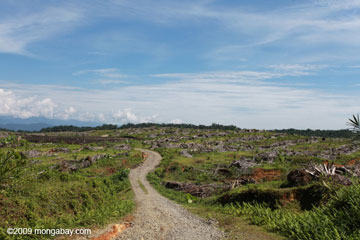 Once rainforest, now palm oil plantation: this monoculture plantation lies near Gunung Leuser National Park in Sumatra. Indonesia this year implemented a moratorium on new logging and plantation concessions with mixed results. Photo by: Rhett A. Butler. |
Indonesia finally passed its much heralded moratorium on new logging and plantation concessions on peatlands and in primary forests areas, but the moratorium was much weaker than expected, reflecting the influence of business-as-usual interests in the forestry sector on the Indonesian government (business-as-usual interests also stepped up pressure on green groups). The moratorium had substantial loopholes, including exclusions for industrial agriculture and mining. But the passage of the moratorium at all, reflected Indonesian President Susilo Bambang Yudhoyono’s seemingly intensified commitment to reducing deforestation. President SBY touted his 7/26 initiative, which targets 7 percent annual economic growth and a 26 percent reduction in greenhouse gas emissions by 2020 relative to business-as-usual. Reducing deforestation and peatlands degradation is the centerpiece of his push toward low carbon development. Meanwhile one major palm oil producer broke ranks and took a bold step forward: Golden Agri Resources (GAR), which had been the target of an intense Greenpeace campaign, announced one of the most progressive forest policies in the palm oil sector, committing not to develop lands with carbon stocks greater than 35 tons per hectares and promising to seek “free, prior informed consent” in engaging with communities. Environmentalists hoped other forestry companies would follow GAR’s lead. Moreover, the Indonesian government said it would ‘recognize, respect and protect’ the rights of traditional forest users, including indigenous people, a move civil society believes is key to reducing deforestation. And finally environmental groups stepped up pressure on pulp and paper companies linked to large-scale destruction of rainforests and peatlands in Sumatra.
Fukushima meltdown (Hance)
On March 11th, tragedy struck Japan in the form of a practically unprecedented (in recent human history) 9.0 earthquake and tsunami. Over 15,000 perished while entire cities were decimated by the worst earthquake in Japan’s history. But the immediate disaster wasn’t the only problem. The earthquake also lead to a meltdown at Fukushima nuclear power plant, which has become the most severe nuclear disaster since Chernobyl. Today, some 90,000 people are displaced by the meltdown with entire Japanese cities standing empty. Experts have predicted that hundreds may die of cancer linked to radiation exposure. The disaster has had global implications, as well, pushing many nations to re-consider nuclear power with Germany being the most notable example. Some warn the disaster could worsen climate change, if nuclear power is phased out for fossil fuels instead of renewables. Others argue that dropping nuclear for renewables could bring about a green energy revolution. Since, the disaster Japan has pledged to speed up deployment of renewable energy as it works to lessen its reliance on nuclear energy.
Extinction hits rhinos (Hance)
 Close up of Vietnamese rhino captured on camera trap before the last individual perished to poachers. Photo courtesy of WWF. |
This year confirmed the extinction of two rhinos: the Vietnamese rhinoceros (Rhinoceros sondaicus annamiticus) and the western black rhinoceros (Diceros bicornis longipes). The last Vietnamese rhinoceros, a subspecies of the Javan rhino, was killed by poachers in 2009, while the last western black rhinos, a subspecies of the black rhino, were killed off in Cameroon. In addition to these tragic losses, South Africa, which is the current epicenter for rhino poaching, hit a new record this year for the number of rhinos killed by poachers: by the end of the yearly it’s likely that around 460 rhinos will have been killed, a nearly 50 percent rise in rhino killing from the previous record set last year. The IUCN Red List categorizes three of the five species of rhino—the black, the Javan, and the Sumatran—as Critically Endangered. Rhinos are being decimated by violent and organized criminals for the black market medicine trade, although numerous studies have shown no medicinal value in rhino horn beyond the placebo effect.
Mixed signals from Brazil on deforestation (Butler)
Brazil announced forest loss during the 2010-2011 deforestation year fell to the lowest level since annual record keeping began in 1988, a continuation of a three-year trend. But enthusiasm for the news was tempered by other developments that could increase risks to the Amazon. In December the Senate voted to revise the country’s long-standing Forest Code, a move environmentalists fear could spark deforestation. The existing Forest Code, which is largely dysfunctional due to lack of consistent enforcement, requires landowners to main 80 percent forest cover on their properties. The new code, which will face a final vote in February or March before going to President Dilma Rousseff for approval, would maintain the headline 80 percent figure in the Amazon, but grant amnesty for illegal deforestation through July 2008 on properties up to 400 hectares (1000 acres) (some greens fear worry the deadline may shift in the future). The new Forest Code would also suspend fines — which fund law enforcement — and relax restrictions on forest clearing along rivers and on mountaintops. Another major development in 2011 was the decision to move forward on Belo Monte dam, a project that would block most of the mighty Xingu river, flooding more than 40,000 hectares of rainforest and displacing thousands of indigenous people. Most disturbing about Belo Monte is the precedents it sets for future large-scale infrastructure projects in the Amazon. For example a federal judge ruled in November that affected communities do not have the right to free, prior and informed consultation on the project. Meanwhile Brazilian companies continued to invest in projects that would drive large-scale deforestation in other Amazon countries, including dams, energy exploration, industrial agricultural developments, and new roads, suggesting that even though deforestation has been ebbing in recent years, there may be leakage to surrounding countries. News of infrastructure investment and development came at the same time as a series of high profile assassination of anti-illegal-logging activists in the Amazon by ranchers and loggers. Finally there were signs some private sector actors continued to be motivated by the stigma of deforestation in their supply chains. JBS-Friboi, the world’s largest meat processor, announced it would stop buying beef from ranches associated with slave labor and illegal deforestation in the Brazilian Amazon, while several banks were sued for failing to follow lending safeguards designed to prevent public finance from being used to subsidize deforestation.
East African drought and famine (Hance)
A punishing drought in East Africa, likely exacerbated by climate change, threatened over 13 million people this year. The crisis proved worst in Somalia, fueled by the nation’s failed government and the militant group al-Shabab. At its height, the UN declared famine in five areas of Somalia; starvation pushed hundreds of thousands of refugees into nearby Kenya, and led to the deaths of an estimated 30,000 children under five. It was the first famine declared by the UN since Ethiopia’s in 1984. Rains had failed in 2010 and were erratic in 2011 in the region, leading up to the crisis. Drought is a regular occurrence in East Africa and communities have long-adapted to dry conditions, however some experts say recent droughts are worsening due to climate change. Unfortunately climate models regarding rainfall in the region have told two different stories: some models have predicted more rainfall in the region, while others have less. However, even if East Africa will see more rainfall instead of less, it’s likely to come in bigger bursts—i.e. flooding—instead of the dependable rain needed for communities. Even as rain has come to the Horn of Africa, food scarcity continues in other parts of vulnerable continent: the UN recently warned that a food crisis could occur in South Sudan and Niger going into 2012.
Sharks see progress worldwide (Hance)
 The oceanic whitetip shark (Carcharhinus longimanus) is listed as Vulnerable by the IUCN Red List. The species has dropped by over 90 percent in the Gulf of Mexico. Photo by: Peter Koelbl. |
In terms of wildlife conservation, 2011 was the year of the shark. Decimated by overfishing, by-catch, and shark finning, some shark populations have dropped by over 90 percent and, according to the IUCN Red List, nearly one-in-three sharks and rays are currently threatened with extinction. Yet this year may mark a turning of the tide for sharks. The end of 2010 began the good news: with the U.S. Senate passing legislation to ban shark fishing in all its waters. Shark finning, which is done solely for shark-fin soup, has led to the death of up to 73 million sharks a year according to one estimate. Meanwhile shark sanctuaries (no shark fishing allowed) have been cropping up all over the place: Palau created the first in 2009, while the Maldives and Raja Ampat Islands of Indonesia followed suit in 2010. Then in 2011 sharks sanctuaries came fast and furious: Honduras became the first nation in the Americas to create a shark sanctuary, followed soon after by Chile and the Bahamas; then Tokelau in the Pacific declared a sanctuary in its waters; finally the Marshall islands created the world’s largest sanctuary, spanning a total area larger than the country of Mexico. Progress wasn’t only made in sanctuaries. In 2010 Hawaii banned shark-fin soup, and at the end of 2011 California did the same. What’s next for sharks? Taiwan has announced Asia’s first ban on shark-finning in its waters beginning next year.
Extreme weather everywhere (Hance)
Another year means another pummeling from extreme weather, increasingly linked to climate change. Last year saw the Russian heatwave, drought in the Amazon, and record floods in South America and Pakistan to name a few. This year, the U.S. suffered a record number of extreme weather events that cost over $1 billion each: twelve. One of the most notable is a drought in Texas that rivals any before 1789. Thailand experienced its worst natural disaster in history in the form of unprecedented monsoon flooding. However a tropical cyclone striking the Philippines brought the largest death toll of any storm this year: over 1,000 people. Failed rains in the Horn of Africa threatened 13 million people with food scarcity and pushed unstable Somalia into famine, killing tens of thousands of people. Drought also hit China while flooding occurred in parts of Central and South America, and Asia. Meanwhile a report from the Intergovernmental Panel on Climate Change (IPCC) found that it was likely (66 percent) that climate change was already contributing to worsening extreme weather. As the world continues to warm, scientists predict such extreme weather will only become more frequent and nastier.
Seven billion people (Hance)
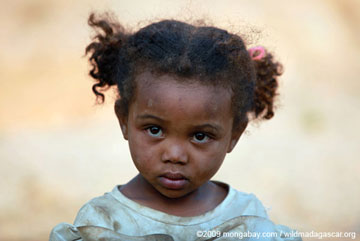 Young girl in Madagascar where 70 percent of children suffer from malnutrition. With booming population growth, 45 percent of Malagasy are under 14. Photo by: Rhett A. Butler. |
Sometime in the late 1960s, when the baby boomers were just coming into their own, an astounding 3.5 billion people graced the planet. This record was the culmination of millions of years of human expansion over almost every environment on Earth. Just over 40 years later—with baby boomers on the verge of retirement—and the global human population has doubled. According to the UN, this year marked the first time seven billion hearts have beat on Earth all at once. The impact is unmistakable as cities swell, forests fall, and the blinking lights of humanity are captured each night by satellite. What does seven billion mean? It means feeding, clothing, housing, and educating twice as many people as before 1970. It means tackling climate change, mass extinction, deforestation, and poverty in a world where the human population continues to grow. It means raising more food on the same land, making freshwater stretch further, and watching wilderness continue to decline. It means added pressure on every ecosystem on Earth from the abyssal ocean, to the most remote Amazon stand, to the glaciers of Greenland. Seven billion requires the need for creative, innovative, at times, wild solutions to global problems. Of course, one could also address overpopulation head-on: proven methods include empowering women, better education, universal access to contraceptives and family planning, reducing poverty, and mitigating child mortality—with all of these non-draconian, non-compulsory methods bringing additional benefits to the community and the world.
Honorable Mentions
Durban sets “road map” (Hance)
For the optimists the agreement made at the 17th UN Framework Convention on Climate Change (UNFCCC) in Durban South Africa was surprisingly good: the Kyoto Protocol lives on; for the first time, 100 percent of the world’s emissions will come under a later agreement in 2020; attendants created a process to address current emissions gap; and the conference saw final approval of the Green Fund to bring billions of dollars in climate aid to the developing world. For the pessimists Durban was another in a long string of disappointing international action on climate change: a new agreement won’t be signed until 2015 and not implemented until 2020; there will be no obligatory cuts by most nations for another 9 years, only pledges; the Green Fund lacks a revenue source, meaning it’s an idea without funding; and the REDD program meant to save forests saw little progress. As for the science of climate change, researchers say emissions must peak this decade and fall rapidly thereafter if the world is to have any real shot of sticking to its pledge of keeping temperatures from rising above 2 degrees Celsius. The conclusion? If nations keep to past pledges while significantly upping their ambition in emissions cuts, if money starts to flow to the developing world and forest-nations, and if the new 2020 agreement is not only hugely ambitious, but actually has some teeth, this may possible.
Arctic rush to drill, drill, drill (Hance)
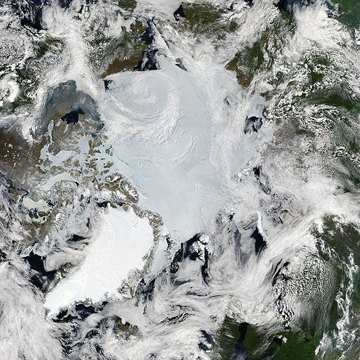 The Arctic as viewed by NASA’s MODIS Satellite in June 2010. Photo by: NASA. |
Climate change, caused by the burning of fossil fuels, is melting sea ice in Arctic, irrevocably changing the fragile environment. So it may seem a bit ironic that the loss of ice is leading to a sudden push to drill more fossil fuels in the very place where they are having the gravest impact, but that’s exactly what’s happening in the Arctic depths. In the U.S. the Obama Administration has granted sweeping approval to a wide swathe of drilling sites in its Arctic waters, despite widespread condemnation from environmentalists and northern indigenous communities. Many of whom warn this is simply setting the stage for an Arctic Deepwater disaster. Russia and Norway are carving up the Barents Sea for exploitation. This rush to drill has not gone unprotested: Greenpeace led a brazen civil disobedience campaign in frigid Baffin Bay this year against Scottish energy company Cairn during exploratory drilling in the deep sea. Greenpeace was able to shut down Cairn’s operations for a couple days, and Greenpeace head, Kumi Naidoo, was arrested trying to board the Cairn oil rig to deliver a protest letter. Aside from more fossil fuels to burn, critics of Arctic drilling say any spill would be practically impossible to clean given the harsh conditions and complete lack-of-infrastructure; oil companies would face freezing temperatures, moving ice, fierce storms, in addition to the fact that any spill would likely have to be abandoned during the long dark Arctic winter. While Greenpeace couldn’t defeat Cairn in its efforts, the Arctic did: the oil company has spent over $600 million drilling wells only to find nothing.
Serengeti Road still on (Hance)
Despite confusion and mixed signals, the Tanzanian government still plans to build a hugely controversial road through Serengeti National Park. In June the Tanzanian Ministry of Natural Resources and Tourism released a statement that the road “would not dissect the Serengeti National Park,” bringing relief and joy to opponents of the road around the world. However, by July it became clear that the Tanzanian government was still planning on building a road, but the path through the park would be gravel, not tarmac. However, observers have always argued that it’s just a matter of time before any road would be upgraded and widened, becoming a commercial route from the sea to the interior. Scientists believe the road will eventually cripple the world’s largest big animal migration—two million wildebeest, zebra, and Thomson’s gazelle pass along this route in annual migration from Tanzania to Kenya—and devastate regional tourism. Tanzania has stated the road is needed to help connect poor communities. However, the German government has offered to build community roads, and critics contend the road’s real purpose is to provide a short path to bring minerals out of Africa’s interior. Concerned NGOs and governments have been pressuring Tanzania to re-consider a southern route that would bypass Serengeti National Park altogether, while others have suggested elevating the road so the migration may pass beneath.
Related articles

REDD advances—slowly—in Durban
(12/15/2011) A program proposed to reduce greenhouse gas emissions from deforestation and degradation made mixed progress during climate talks in Durban. Significant questions remain about financing and safeguards to protect against abuse, say forestry experts. REDD+ aims to reduce deforestation, forest degradation, and peatland destruction in tropical countries. Here, emissions from land use often exceed emissions from transportation and electricity generation. Under the program, industrialized nations would fund conservation projects and improved forest management. While REDD+ offers the potential to simultaneously reduce emissions, conserve biodiversity, maintain other ecosystem services, and help alleviate rural poverty, concerns over potential adverse impacts have plagued the program since its conception.
Deforestation could be stopped by 2020
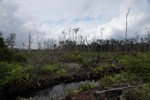
(11/28/2011) If governments commit to an international program to save forests known as REDD+, deforestation could be nearly zero in less than a decade, argues the Living Forests Report from the World Wide Fund for Nature (WWF). REDD+, which stands for Reduced Emissions from Deforestation and Degradation, is a program that would pay developing nations to preserve forests for their ability to sequester carbon. Government officials begin meeting tomorrow in Durban, South Africa for the 17th UN climate summit, and REDD+ will be among many topics discussed.
Arctic sea ice melt ‘unprecedented’ in past 1,450 years
(11/24/2011) Recent arctic sea ice loss is ‘unprecedented’ over the past 1,450 years, concludes a reconstruction of ice records published in the journal Nature.
IEA warns: five years to slash emissions or face dangerous climate change
(11/13/2011) Not known for alarmism and sometimes criticized for being too optimistic, the International Energy Agency (IEA) has warned that without bold action in the next five years the world will lock itself into high-emissions energy sources that will push climate change beyond the 2 degrees Celsius considered relatively ‘safe’ by many scientists and officials.
A final farewell: the Western Black Rhino goes extinct
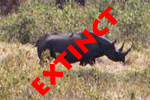
(11/12/2011) The western black rhinoceros (Diceros bicornis longipes) roams the woodlands of Africa no more. The rhino, one of four sub-species of black rhino, was declared extinct this week by the IUCN, five years after the last extensive survey of its habitat in Cameroon. The rhino becomes the second declared extinct this year. All rhinos are threatened by the rhino horn trade.
Obama Administration bows to pressure, delays tar sands pipeline
(11/10/2011) In what can only be described as a major victory for green activists, the Obama Administration has announced it will delay a decision on TransCanada’s controversial Keystone XL pipeline for 12-18 months. Notably, putting the decision off until after the last election. The delay comes less than a week after about 12,000 people encircled the White House in opposition to the Keystone XL pipeline, which they argue threatens one of the most important water supplies in America’s heartland and will worsen climate change.
(11/09/2011) Indigenous communities do not have the right to free, prior and informed consultation on the Belo Monte dam because its infrastructure and reservoirs would not be physically located on tribal lands, ruled a Brazilian court.